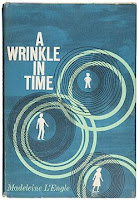Journey through time and space in this 1962 Newbery Medal Winner by Madeleine L'Engle
"And we're not alone, you know, children...All through the universe it's being fought, all through the cosmos, and my, but it's a grand and exciting battle. I know it's hard for you to understand about the size, how there's very little difference in the size of the tiniest microbe and the greatest galaxy. You think about that, and maybe it won't seem strange to you that some of our very best fighters have come right from your own planet, and it's a little planet, dears, out on the edge of a little galaxy..."
"Who have our fighters been?"
"Oh, you must know them, dear...'And the light shineth in darkness; and the darkness comprehended it not.'"
"Jesus!" Charles Wallace said. "Why of course, Jesus!"
"Of course!...Go on Charles, love. There were others. All your great artists. They've been lights for us to see by."
This science-fantasy novel takes us through the quest of a teenage girl, Meg, trying to find her father who has been missing for several years. After a late-night encounter with an interesting old woman, Meg soon finds herself flying through the universe on a centaur-like creature who morphs into an old woman. Accompanied by her younger brother, Charles Wallace, and a new friend and romantic interest, Calvin, Meg journeys through time and space in search of her father who is being held captive by a massive evil force.
L'Engle describes a method of time travel called tesseract, which acts as a sort of wormhole through which one travels the time-space continuum; hence, the wrinkle...in time. Meg, Charles, and Calvin begin to travel into other dimensions and to other planets in distant galaxies with some eccentric old (and by old I mean thousands of years old) women, Mrs. Whatsit, Mrs. Who, and Mrs. Which.
Besides the science fiction aspect, the novel contains many themes that permeate time and space in the spiritual sense. The connection between Meg and her father despite the immense physical separation presents a familial theme that love, especially between parent and child, exists beyond the physical and temporal. This can also be said of Christ and his role in the story of humanity and the effect of his actions on earth. His sacrifice--his love--transcends time and space in a way that we see Meg striving after her father while on earth and in other dimensions. With that, the themes of light and dark and good versus evil result from the struggle of the quest.


No comments:
Post a Comment